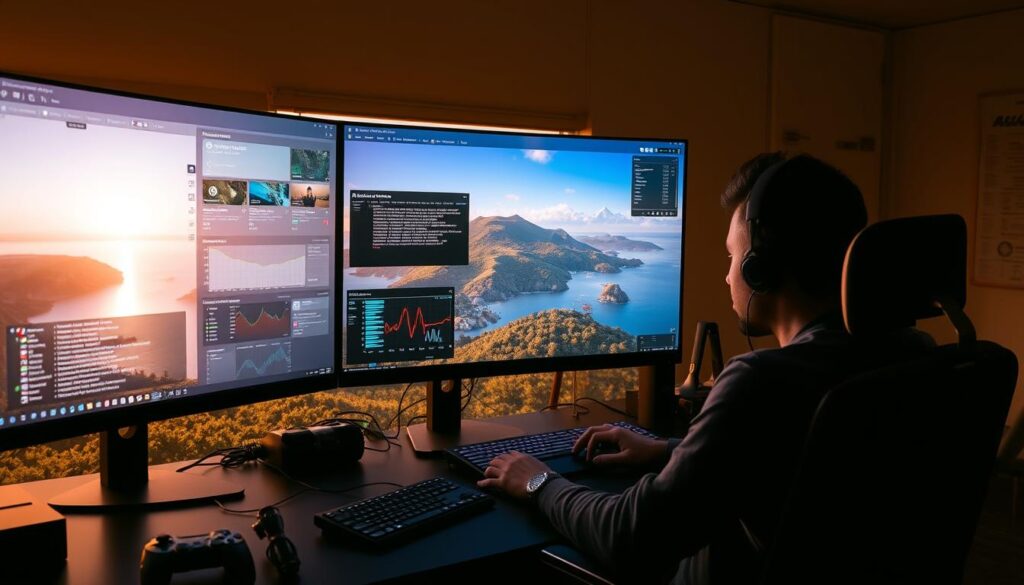Ever wondered how survival mobile games create endless worlds? The secret is procedural island generation. This technique not only makes games better but also brings its own set of challenges. We’ll look at how game monitoring helps improve procedural content generation.
Knowing how to monitor these systems is key for developers. It helps them create dynamic environments that meet players’ needs and likes.
In this article, you’ll learn about methods, tools, and best practices for developers. By the end, you’ll know how to make your survival mobile games more engaging. You’ll be able to create unforgettable player experiences.
Understanding Procedural Island Generation
Procedural island generation uses advanced algorithms to create varied game worlds automatically. It lets developers set parameters like scale, terrain, and biomes. This way, they can make landscapes that are both unique and engaging.
Random seed values are key in this process. They affect the algorithms, making each player’s experience unique. This is especially important in survival games, where it boosts exploration and fun.
Procedural generation greatly enhances player engagement. It offers endless island possibilities, bringing new challenges and adventures. This approach makes the game more enjoyable and encourages players to keep coming back.

The Importance of Monitoring in Game Development
Monitoring is key in game development, especially for procedural island generation. It helps developers keep the game world balanced and fun. By watching how players play, they can fix issues and make the game smoother.
Player feedback is crucial as the game grows. Developers use monitoring to tweak the game based on player actions. This focus on monitoring leads to careful adjustments, making the game more engaging and satisfying. This cycle of feedback and improvement keeps the game exciting and competitive.

Techniques for Monitoring Procedural Island Generation
Monitoring procedural island generation is key in game development. It ensures a smooth gaming experience and checks the quality of the content. Debugging tools are essential, helping developers track the generation process and spot any problems.
Performance metrics are also crucial. They show how well the algorithms work, highlighting any issues that might slow down the game.
Algorithm analysis is another important method. It lets developers check if the procedural generation meets their standards. By setting benchmarks, they can see how well the islands look and play.
Using these techniques helps improve procedural generation. Regular checks and tweaks make the game better, showing the power of good design.
Using Perlin Noise for Realistic Terrain Generation
Perlin noise is a key tool for making game landscapes look real. It helps developers create smooth, natural-looking terrains. This method makes sure the terrain looks connected and realistic, improving the game’s feel.
To use Perlin noise in Unity, you need to set up a few things. You have to adjust the frequency and amplitude of the noise. Frequency controls how detailed the terrain is, and amplitude changes the height. These tweaks help make the game world feel real and varied.
Using Perlin noise does more than just make things look good. It makes terrains that feel like they’re part of a real world. This is especially useful in survival games, where players need to explore and interact with the environment.
Implementing Random Seed Generation for Replayability
Random seed generation is key in procedural generation for survival games. It makes each game world unique, boosting replay value. Players can go back to old worlds, seeing the same changes and challenges.
This approach helps game mechanics by creating a cycle of exploration. Players get to see new landscapes and challenges. They can try different strategies each time, making the game more dynamic.
For developers, random seed generation is a big help. They can easily recreate bugs by using the same seed. This makes fixing issues faster and keeps the game fun and fair.
Grid-Based Generation: Structuring Your Game World
Grid-based generation is key in creating game worlds. It helps developers manage coordinates well. This makes it easier to organize game elements.
It’s great for pixel art games because it keeps everything looking the same. Each cell on the grid can be a different tile or object. This makes building the world easier and looks better.
Using this method also makes games run smoother. It’s easier to load and show assets. Plus, it’s simple to plan how things will work together. This makes creating complex environments easier.
Benefits of Procedural Generation in Survival Games
Procedural generation in survival games offers many advantages. It cuts down on development time and costs. Developers can make vast landscapes using algorithms, saving resources while creating deep experiences.
It leads to dynamic environments that change with each play. Players get different experiences as landscapes and challenges evolve. This keeps players engaged, encouraging them to keep exploring and adapting.
Also, it helps keep players coming back for more. Every session is unique, offering new terrains and challenges. This variety is key to modern survival games, making them more enjoyable.
In short, procedural generation brings many benefits to survival games. It makes development faster and creates engaging, changing environments for players.
Challenges in Monitoring Procedural Island Generation
Monitoring procedural island generation comes with its own set of challenges. One big issue is making sure the content doesn’t get boring over time. Developers need to make each island unique to keep players interested.
Another challenge is fixing bugs that pop up when players interact with the game in new ways. These interactions can reveal flaws in the algorithms used for procedural generation. Finding and fixing these problems takes a lot of effort and patience.
Managing what players expect is also tough. Players often have certain ideas about what procedural generation means. If reality doesn’t match these expectations, it can upset them. Developers must find a balance by mixing random elements with carefully designed parts.
By tackling these challenges, developers can make their procedural generation systems better. This leads to more exciting and varied experiences for players. Overcoming these hurdles might mean trying different approaches and always looking to improve.
Game Development Tools: Unity and C# for Procedural Generation
Unity is a top choice for game development, especially for procedural generation. Its powerful engine makes it easy to add complex algorithms. This gives developers a wide space to be creative.
C# is key in Unity, offering a simple yet effective programming language. It helps developers write scripts that control game actions. This is crucial for making games that change and grow.
Unity’s visual tools are a big plus. They let developers see their creations come to life. Plus, the Unity Asset Store has many tools for procedural generation.
Unity and C# together help make games that feel alive and keep changing. Developers can build endless worlds with unique features. These tools boost creativity and keep players coming back for more.
| Feature | Unity | C# |
|---|---|---|
| Programming Language | Visual scripting options available | Flexible and powerful scripting capabilities |
| Asset Management | Asset Store for additional resources | Custom libraries can be created |
| Community Support | Large online community and forums | Extensive documentation and tutorials |
| Performance Optimization | Efficient processing for complex assets | Optimized for handling diverse game functions |
Assessing Landscape Parameters for Effective Monitoring
Understanding landscape parameters is key for monitoring procedural island generation in survival mobile games. It’s important to assess these elements well. This helps create immersive environments that make the game more enjoyable.
This section will look at evaluating terrain settings and fine-tuning water and mountain frequencies. These steps are crucial for creating diverse biomes that offer unique player experiences.
Evaluating Terrain Settings
When evaluating terrain settings, consider elevation, erosion strength, and landscape radius. These factors greatly affect the game’s visual appeal and playability. Adjusting these parameters allows developers to create varied biomes.
This variety leads to unique player experiences. It makes the game world feel authentic and engaging.
Fine-Tuning Water and Mountain Frequencies
Water and mountain frequencies are key in terrain generation. Balancing these frequencies is crucial for the landscape’s aesthetics and gameplay functionality. Water frequency affects how water bodies are spread out, while mountain frequency impacts mountainous regions.
This fine-tuning ensures the game world feels real and engaging. It makes the game more enjoyable for players.
| Terrain Setting | Description | Impact on Gameplay |
|---|---|---|
| Elevation | Defines height variations in the landscape, affecting visibility and movement. | Creates tactical challenges and exploration opportunities. |
| Erosion Strength | Controls the degree of terrain wear, altering landforms over time. | Enhances realism in environmental changes. |
| Landscape Radius | Determines the area affected by terrain features. | Impacts the size and scope of biomes. |
| Water Frequency | Measures the distribution and size of water bodies in the terrain. | Affects resource availability and navigation. |
| Mountain Frequency | Regulates the density of mountainous regions. | Influences exploration routes and strategic advantages. |
Dynamic Gameplay: Responding to Player Interactions
Dynamic gameplay is key in procedural island generation. It makes the environment change based on what players do. When players make choices, the game adjusts, offering a fresh experience each time.
As players explore, the game reacts to their actions. This creates unique scenarios every time. It makes the game more immersive and builds a strong connection between players and their experiences.
Creating game mechanics that focus on dynamic gameplay encourages players to be more active. Whether it’s changing landscapes, new challenges, or different wildlife interactions, a game that evolves is more rewarding.
Best Practices for Debugging Procedural Island Generation
Debugging procedural generation in games is key for a smooth player experience. Using best practices makes this process more efficient. Testing over and over is a basic but crucial step. It helps find problems early on.
Debug logs are also very important. They show how procedural generation works and point out any problems. They track important details, helping to fine-tune the island generation.
Creating test scenarios that can be repeated is essential. This lets developers see how the procedural island generation works under different conditions. It helps spot and fix issues more easily.
By following these steps, developers build a solid foundation for debugging. This ensures the procedural generation runs smoothly, making the game better for players.
| Debugging Practice | Description | Benefits |
|---|---|---|
| Iterative Testing | Continuously testing the game while developing. | Identifies issues early in the process. |
| Debug Logs | Tracking variables and outcomes during gameplay. | Provides insights into the procedural generation. |
| Reproducible Scenarios | Setting specific conditions to test generation. | Focuses debugging efforts on irregularities. |
Case Studies: Successful Implementation of Procedural Generation
Game design success stories often highlight remarkable instances of procedural generation. This technique reshapes gameplay experiences. Notable examples include No Man’s Sky and Minecraft. Both games use procedural algorithms to create vast, dynamic environments that captivate players.
No Man’s Sky uses procedural generation to produce an expansive universe. It has millions of planets, each with unique ecosystems and traits. This allows for infinite exploration, letting players discover diverse landscapes, flora, and fauna. Such case studies show the game’s commitment to delivering a rich player experience.
Minecraft exemplifies how procedural generation can foster creativity. Its world generation system creates various terrains, from mountains to valleys. This provides players with endless opportunities for building and exploration. These stories not only show the effectiveness of procedural generation but also inspire developers to use similar methods in their games.
Insights from these case studies reveal crucial aspects of procedural generation’s implementation. They highlight the importance of algorithmic creativity in game design. As game developers reflect on these success stories, they gain valuable knowledge and inspiration to use procedural techniques in their projects.
Future Trends in Procedural Generation for Mobile Games
Mobile game development is always changing, and procedural generation is leading the way. New technologies like machine learning and generative adversarial networks (GANs) are coming. These could change how we make dynamic game worlds.
Machine learning can study how players play and what they like. It can then change the game to fit each player’s style. GANs help make detailed landscapes, making games more realistic without needing much human work.
Games will also have better graphics and more complex systems. This means players will get to explore rich, unique worlds. These changes will make games more fun and keep them interesting for longer, thanks to endless content possibilities.
Conclusion
This article has covered the key parts of monitoring procedural island generation. It shows how important it is for better player experiences and game development. Using Perlin noise and random seeds, developers can make exciting, changing worlds. These worlds draw players in and encourage them to explore.
It’s vital to have good monitoring to find and fix problems. This makes sure the procedural islands fit the game’s rules. Using these methods makes game development smoother and improves survival mobile games.
As games keep getting better, developers should use procedural generation. This opens up new ways to be creative and innovative. The future of games looks bright, and those who adapt will see more engaged and happy players.
FAQ
What is procedural island generation in mobile survival games?
Procedural island generation is when algorithms create game worlds. This makes each player’s experience unique, adding to the fun of exploring and surviving.
Why is monitoring procedural generation important in game development?
It keeps the game balanced and fixes bugs. Developers can improve the game by tweaking algorithms based on what players say. This makes the game more fun.
What techniques can be used to monitor procedural island generation?
You can use debugging tools and check how well the game runs. Also, analyzing algorithms and setting benchmarks helps make sure the game content is good.
How does Perlin noise contribute to terrain generation?
Perlin noise makes terrains look natural and smooth. It reduces randomness and connects points, creating realistic landscapes.
What is the role of random seed generation in games?
It lets players have the same but different worlds. This boosts replay value and helps developers find and fix bugs.
What are the advantages of a grid-based approach in procedural generation?
It makes managing coordinates easier and keeps designs consistent. It’s great for pixel art games, making world-building more organized.
What benefits does procedural generation offer to developers and players?
It saves time and money while making games bigger and more varied. This keeps players interested and happy.
What challenges do developers face when monitoring procedural generation?
They might create boring content, find bugs, and deal with player expectations. They need to mix hand-crafted and generated elements.
How does Unity support procedural content generation?
Unity is flexible and has tools for complex algorithms. This helps developers create immersive worlds that players love.
How can landscape parameters be assessed for effective monitoring?
Look at things like erosion strength and landscape radius for realism. Adjusting water and mountain details helps create perfect biomes.
What is dynamic gameplay within procedural island generation?
It’s when the game changes based on what the player does. This makes the game more immersive and keeps players interested.
What are the best practices for debugging procedural island generation?
Test often, use debug logs, and make scenarios that can be repeated. This helps find and fix problems, making the game smoother.
Can you provide examples of successful implementations of procedural generation?
Games like No Man’s Sky and Minecraft use algorithms to create huge worlds. They show new ways to make games more exciting.
What future trends in procedural generation should developers be aware of?
Look out for better machine learning and GANs. They will help make terrains and content even more realistic and dynamic.




